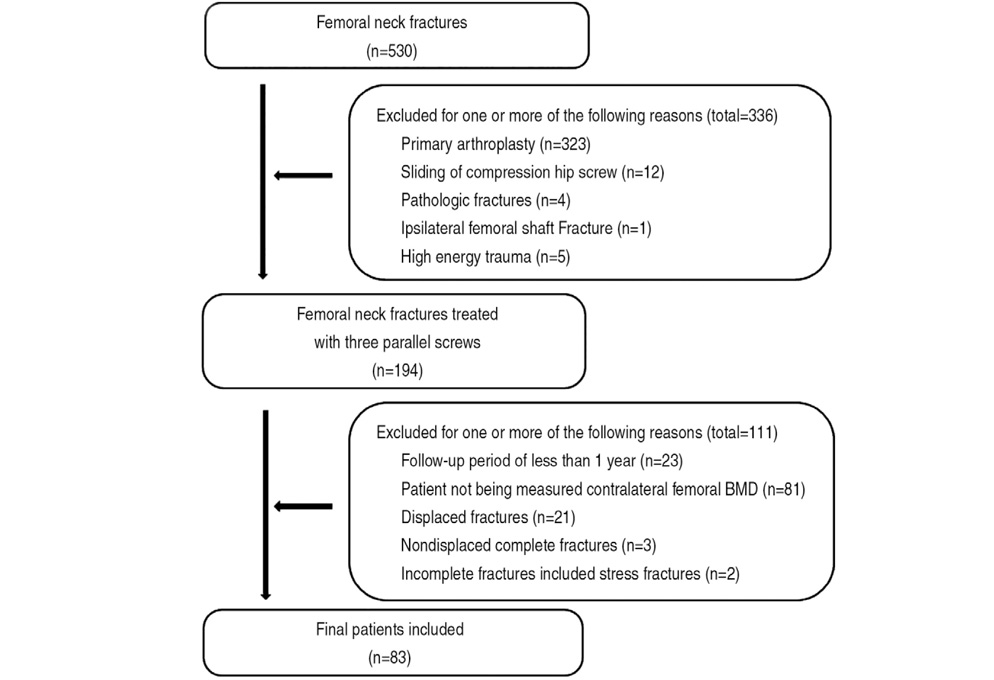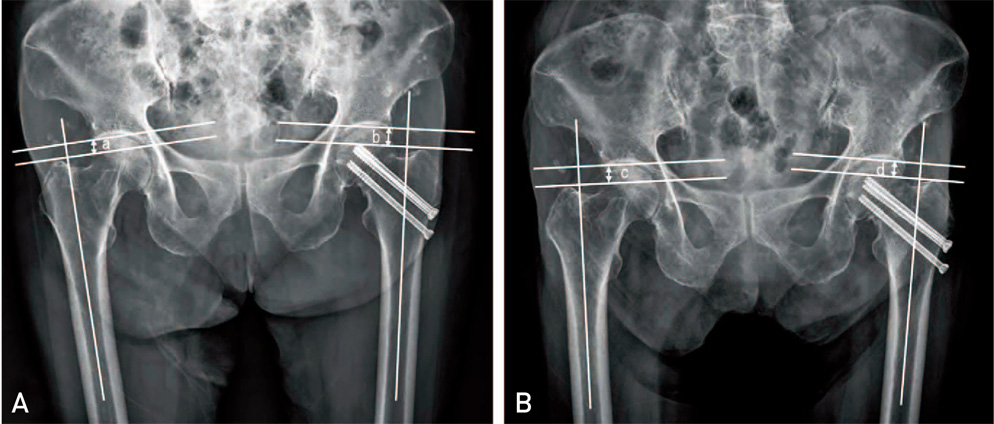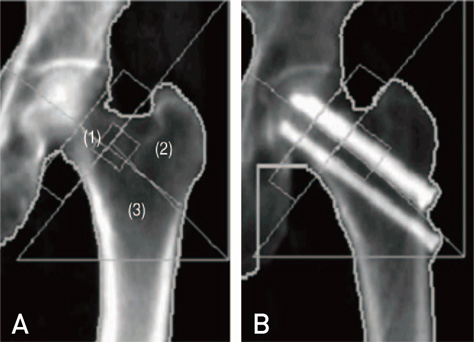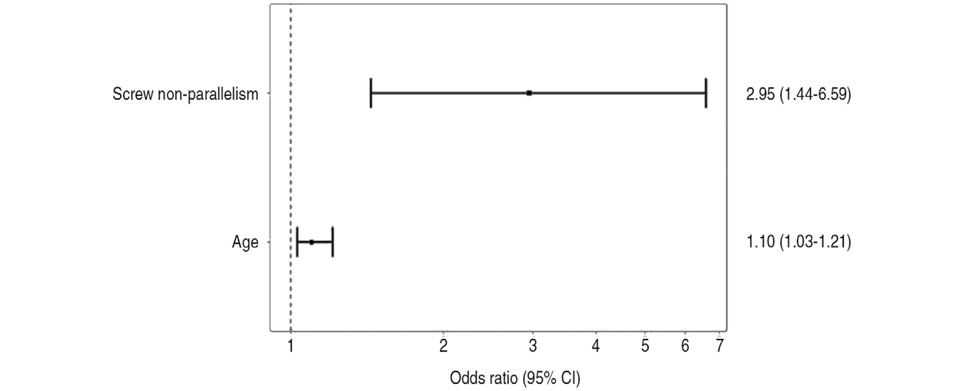Hip Pelvis.
2017 Dec;29(4):277-285. 10.5371/hp.2017.29.4.277.
Risk Factors for Neck Shortening in Patients with Valgus Impacted Femoral Neck Fractures Treated with Three Parallel Screws: Is Bone Density an Affecting Factor?
- Affiliations
-
- 1Department of Orthopaedic Surgery, Sanggye Paik Hospital, Inje University College of Medicine, Seoul, Korea. sinceric@paik.ac.kr
- KMID: 2424255
- DOI: http://doi.org/10.5371/hp.2017.29.4.277
Abstract
- PURPOSE
The purpose of this study is to analyze the relationship between significant femoral neck shortening (SFNS) and bone density after three parallel screw fixation in valgus impacted femoral neck fracture, and to analyze the risk factors for SFNS.
MATERIALS AND METHODS
This is retrospective study of 83 patients. We performed univariate analysis for patient information, bone density, fracture configuration and screw position divided into SFNS group (n=13) and non-SFNS group (n=70) and performed multivariate analysis using logistic regression model. We also analyzed the relationship between SFNS and complications such as osteonecrosis of femoral head and nonunion.
RESULTS
There was a significant difference in age, screw non-parallelism and bone mineral density of intertrochanteric and total hip area in the univariate analysis between the two groups (P < 0.05). In multivariate analysis, old age (odds ratio [OR], 1.10; 95% confidence interval [CI], 1.03-1.21) and screw non-parallelism (OR, 2.95; 95% CI, 1.44-6.59) were significant risk factors for SFNS. The incidence of SFNS was significantly higher in the complication group (P=0.027).
CONCLUSION
Bone density did not significantly affect SFNS in valgus impacted femoral neck fractures treated with three parallel screws. The risk factors of SFNS were old age and screw non-parallelism. Therefore, we recommend using other fixation method to prevent SFNS in older ages and making the screw position as parallel as possible when performing screw fixation in valgus impacted femoral neck fracture.
MeSH Terms
Figure
Cited by 1 articles
-
Surgical Outcomes of Internal Fixation Using Multiple Screws in Femoral Neck Fractures with Valgus Impaction: When Should We Consider Hip Arthroplasty? A Retrospective, Multicenter Study
Nam Hoon Moon, Won Chul Shin, Jae Hoon Jang, Han Ul Seo, Jung Yun Bae, Kuen Tak Suh
Hip Pelvis. 2019;31(3):136-143. doi: 10.5371/hp.2019.31.3.136.
Reference
-
1. Court-Brown CM, Caesar B. Epidemiology of adult fractures: a review. Injury. 2006; 37:691–697.
Article2. Raaymakers EL. The non-operative treatment of impacted femoral neck fractures. Injury. 2002; 33:Suppl 3. C8–C14.
Article3. Damany DS, Parker MJ. Varus impacted intracapsular hip fractures. Injury. 2005; 36:627–629.
Article4. Liu Y, Ai ZS, Shao J, Yang T. Femoral neck shortening after internal fixation. Acta Orthop Traumatol Turc. 2013; 47:400–404.
Article5. Selvan VT, Oakley MJ, Rangan A, Al-Lami MK. Optimum configuration of cannulated hip screws for the fixation of intracapsular hip fractures: a biomechanical study. Injury. 2004; 35:136–141.
Article6. Zlowodzki M, Ayeni O, Petrisor BA, Bhandari M. Femoral neck shortening after fracture fixation with multiple cancellous screws: incidence and effect on function. J Trauma. 2008; 64:163–169.
Article7. Zlowodzki M, Brink O, Switzer J, et al. The effect of shortening and varus collapse of the femoral neck on function after fixation of intracapsular fracture of the hip: a multi-centre cohort study. J Bone Joint Surg Br. 2008; 90:1487–1494.8. Noda M, Saegusa Y, Takahashi M, et al. Diminished abductor muscular strength in patients with valgus-impacted femoral neck fractures treated by internal fixation: Clinical study and biomechanical considerations. J Orthop Surg (Hong Kong). 2017; 25:2309499017716070.
Article9. Shimizu T, Miyamoto K, Masuda K, et al. The clinical significance of impaction at the femoral neck fracture site in the elderly. Arch Orthop Trauma Surg. 2007; 127:515–521.
Article10. Yoon PW, Shin YH, Yoo JJ, Yoon KS, Kim HJ. Progression of a fracture site impaction as a prognostic indicator of impacted femoral neck fracture treated with multiple pinning. Clin Orthop Surg. 2012; 4:66–71.
Article11. Chen X, Zhang J, Wang X, Ren J, Liu Z. Incidence of and factors influencing femoral neck shortening in elderly patients after fracture fixation with multiple cancellous Screws. Med Sci Monit. 2017; 23:1456–1463.
Article12. Klatte TO, Vettorazzi E, Beckmann J, Pueschel K, Amling M, Gebauer M. The Singh Index does not correlate with bone mineral density (BMD) measured with dual energy X-ray absorptiometry (DXA) or peripheral quantitative computed tomography (pQCT). Arch Orthop Trauma Surg. 2015; 135:645–650.
Article13. Wang SH, Yang JJ, Shen HC, Lin LC, Lee MS, Pan RY. Using a modified Pauwels method to predict the outcome of femoral neck fracture in relatively young patients. Injury. 2015; 46:1969–1974.
Article14. Yang JJ, Lin LC, Chao KH, et al. Risk factors for nonunion in patients with intracapsular femoral neck fractures treated with three cannulated screws placed in either a triangle or an inverted triangle configuration. J Bone Joint Surg Am. 2013; 95:61–69.
Article15. Gurusamy K, Parker MJ, Rowlands TK. The complications of displaced intracapsular fractures of the hip: the effect of screw positioning and angulation on fracture healing. J Bone Joint Surg Br. 2005; 87:632–634.16. Zalavras CG, Lieberman JR. Osteonecrosis of the femoral head: evaluation and treatment. J Am Acad Orthop Surg. 2014; 22:455–464.17. Nikolopoulos KE, Papadakis SA, Kateros KT, et al. Longterm outcome of patients with avascular necrosis, after internal fixation of femoral neck fractures. Injury. 2003; 34:525–528.
Article18. Landis JR, Koch GG. The measurement of observer agreement for categorical data. Biometrics. 1977; 33:159–174.
Article19. Goldhahn J, Suhm N, Goldhahn S, Blauth M, Hanson B. Influence of osteoporosis on fracture fixation--a systematic literature review. Osteoporos Int. 2008; 19:761–772.
Article20. Eckstein F, Lochmüller EM, Lill CA, et al. Bone strength at clinically relevant sites displays substantial heterogeneity and is best predicted from site-specific bone densitometry. J Bone Miner Res. 2002; 17:162–171.
Article21. Viberg B, Ryg J, Overgaard S, Lauritsen J, Ovesen O. Low bone mineral density is not related to failure in femoral neck fracture patients treated with internal fixation. Acta Orthop. 2014; 85:60–65.
Article22. Conn KS, Parker MJ. Undisplaced intracapsular hip fractures: results of internal fixation in 375 patients. Clin Orthop Relat Res. 2004; (421):249–254.23. Sikand M, Wenn R, Moran CG. Mortality following surgery for undisplaced intracapsular hip fractures. Injury. 2004; 35:1015–1019.
Article24. Boraiah S, Paul O, Hammoud S, Gardner MJ, Helfet DL, Lorich DG. Predictable healing of femoral neck fractures treated with intraoperative compression and length-stable implants. J Trauma. 2010; 69:142–147.
Article25. Takigawa N, Yasui K, Eshiro H, et al. Clinical results of surgical treatment for femoral neck fractures with the Targon® FN. Injury. 2016; 47:Suppl 7. S44–S48.
Article26. Papanastassiou ID, Mavrogenis AF, Kokkalis ZT, Nikolopoulos K, Skourtas K, Papagelopoulos PJ. Fixation of femoral neck fractures using divergent versus parallel cannulated screws. J Long Term Eff Med Implants. 2011; 21:63–69.
Article27. Gümüştaş SA, Tosun HB, Ağlri , Orak MM, Onay T, Okçu G. Influence of number and orientation of screws on stability in the internal fixation of unstable femoral neck fractures. Acta Orthop Traumatol Turc. 2014; 48:673–678.
Article28. Stockton DJ, Lefaivre KA, Deakin DE, et al. Incidence, magnitude, and predictors of shortening in young femoral neck fractures. J Orthop Trauma. 2015; 29:e293–e298.
Article29. Saito N, Miyasaka T, Toriumi H. Radiographic factors predicting non-union of displaced intracapsular femoral neck fractures. Arch Orthop Trauma Surg. 1995; 114:183–187.
Article30. Alho A, Benterud JG, Rønningen H, Høiseth A. Prediction of disturbed healing in femoral neck fracture. Radiographic analysis of 149 cases. Acta Orthop Scand. 1992; 63:639–644.
- Full Text Links
- Actions
-
Cited
- CITED
-
- Close
- Share
- Similar articles
-
- The Result of In Situ Pinning for Valgus Impacted Femoral Neck Fractures of Patients over 70 Years Old
- The Effects and Risk Factors of Femoral Neck Shortening after Internal Fixation of Femoral Neck Fractures
- A Simple Percutaneous Technique to Reduce Valgus-Impacted Femoral Neck Fractures
- Postoperative Valgus Deformity and Progression of Ostheoarthritis in Non-Displaced Femoral Neck Fractures
- Clinical Results of Internal Fixation of Subcapital Femoral Neck Fractures





